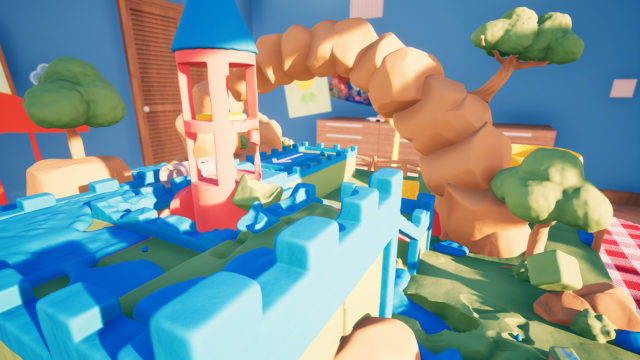Great visuals; fun concept; clay mechanics feel authentic; engaging puzzles
Overly brief; challenge is too low; some redundancies in the game's presentation, particularly the soundtrack
Claybook is an interesting little game. Clocking in at just 20 levels (not counting what can be made and downloaded via the level creator, which we’ll cover in more detail in a moment), the game isn’t packed with content, but what’s here is both engaging and innovative. There are only a handful of objectives that the player must meet within each level in order to claim victory, but how the player can go about accomplishing them is what really makes Claybook shine. Its lack of challenge and relative dearth of stages notwithstanding, this is a genuinely enjoyable experience that is geared towards younger players but will still be satisfying to older ones, as well.
The overarching premise of Claybook is that the entire world is made of clay. There are five books, each containing four levels, that have various themes at play which inform the visuals. The result is a nice variety of locales, but what makes them special is that aforementioned clay. Everything in the game looks soft and squishy, exactly as it should if it were truly hewn from clay. Claybook developer Second Order went to great pains to give the game a visual style that’s somehow simultaneously grounded and fantastical, and they largely succeeded.
It’s some impressive presentation, certainly, but there are some oddities that stand out. For one thing, the kid in the background feels out of place and stands too starkly in contrast with the rest of his surroundings. In short, he doesn’t look like he belongs in the same game. More frustrating is the lack of musical and environmental variance. The soundtrack is solid but repetitive and the only background is the playroom where Claybook is set. It certainly helps to establish a sense of place as the game unfolds, but at least some optional, different backgrounds would have been welcome.
Gameplay in Claybook is impressively evocative of playing with actual clay. The player controls a sentient, rolling ball of the material which can be formed into a wide array of shapes and forms. Solving Claybook’s puzzles depends on both manipulating the clay as well as knowing how to interact with the game world itself. The environment is essentially destructible because it’s built from clay, with the movement of the player’s ball actively serving to reshape and alter it. Progressing through Claybook requires the player to understand the limits of the malleability of the ball, the world around it, and the interplay between the two.
Unfortunately, sometimes Claybook’s clever physics get a bit unwieldy. It can occasionally feel like the game is glitching when the clay becomes overly distorted or stretched. This is alleviated in part by a handy rewind feature which allows players to replay segments of a level if they get stuck or the clay gets unmanageable. It’s a useful mechanic, certainly, but it also feels like a workaround employed by the design team to avoid fixing some of the bugs and flaws embedded in how the clay functions within the game world.
That all said, Claybook largely controls well much more often than it does not, which makes its brevity all the harder to swallow. It only takes a few hours to get through Claybook due to the limited number of levels mentioned above, but the situation is exacerbated by its lack of difficulty. In fairness, Claybook is meant for younger players (or at least, that’s the audience it seems to be targeting) and some of the challenge increases towards the end, but typically it doesn’t take too much thought to divine how a puzzle is meant to be solved. Having the choice to manually increase the difficulty level would have been a great way to make Claybook more readily accessible to new and seasoned players, alike.

One curious element that Second Order included in Claybook is a surprisingly robust level editor. Players can build their own levels and then share them with one other online, which greatly adds to Claybook’s replay value. User-generated content is always hit or miss in regards to quality, but considering it doesn’t cost anything to give other player creations a shot, it’s a welcome sight in light of Claybook’s limited pre-installed stages. One caveat here is that the controls for the level editor aren’t especially intuitive. Players more familiar with actual game design software will have the smallest learning curve, but for everyone else there will be a stretch of trial and error.
All in all, Claybook has its faults, but there’s a lot to love that makes any blemishes worth tolerating. The game’s rewind feature is a big help in circumnavigating some of these flaws, but it would have been nice to see a touch more polish injected into Claybook. The experience will zoom by for most players, but the ability to create, share, and download levels from other users helps to pad things out. Still, player-created content doesn’t please everyone, so know going into Claybook that it will be fun, if brief. Definitely give it some thought when perusing the eShop.
Nintendojo was provided a copy of this game for review by a third party, though that does not affect our recommendation. For every review, Nintendojo uses a standard criteria.




 ShareThis
ShareThis





